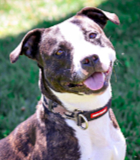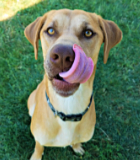Begging at the Table
- This topic has 0 replies, 1 voice, and was last updated 14 years, 11 months ago by
Mackenzie’s Admin.
-
AuthorPosts
-
June 11, 2010 at 6:43 pm #528
Mackenzie’s Admin
MemberBegging at the Table
What happens when you walk into a house and encounter the delicious aroma of your favorite home-cooked meal or freshly baked cookies? You probably gravitate toward the kitchen without even thinking about it, especially if you’re hungry. Because most dogs enjoy the same kinds of foods that we do, it’s not surprising that they’re drawn to good smells, too. However, many pet parents don’t like it when they sit down at the table to eat and find themselves under the intense scrutiny of their hopeful, drooling dogs.
You can’t really blame your dog for begging at the table. But if you’d like to change her behavior, you can do so by using one or both of the following tactics:
Prevent begging by controlling your dog’s access to the table.
Teach your dog to do something else instead, such as lying down and staying on a mat or bed.Prevent the Problem
Sometimes it’s easiest to solve a problem by preventing it from happening. If you’d rather your dog leave you alone while you eat, you can use a baby gate to confine her to another room when you sit down for a meal. Or, if your dog is crate trained, you can put her in her crate while you eat. (Please see our article on Weekend Crate Training to learn how to teach your dog to happily relax in a crate.) To keep her busy and quiet, try giving your dog a chew bone, her dinner or a KONG® toy stuffed with something delicious. (Please see our article on How to Stuff a KONG Toy to learn more about using food puzzle toys.)If you’d like your dog to stay in the same room with you but refrain from loitering right next to the table or drooling on your shoes, you can use a tether to keep her in her own space. Attach a short leash or tether (four- to six-feet long) to a heavy piece of furniture or an eye-hook in the baseboard. (You can buy a length of chew-proof plastic-coated wire with a clip on each end at most pet stores.) Put a soft bed or mat next to the tether. Before sitting down to eat, lead your dog to her comfy spot, and attach the leash or tether to her collar. Then give her something to chew or a stuffed KONG. After you finish your meal, you can release her from the tether. As long as you give your dog a tasty treat of her own to work on while you eat, she’ll enjoy settling in her special spot during mealtimes. (A word of caution: Do not leave your dog unattended while she’s tethered. She could get tangled in the tether and injure herself.)
Teach Your Dog to Go to Her Spot and Stay
If you don’t want to confine your dog in an area away from the table or use a tether to restrain her, you can teach her to go to a designated spot, usually a bed or a mat, and stay there. This skill can be useful in a variety of other situations, too. If you’re watching a movie with friends and you’d like your dog to occupy herself for a while, you can ask her to go to her spot and chew a bone. If your dog jumps up on people when they come to the door, you can ask her to go to her spot whenever the doorbell rings and wait there to greet visitors. If you take your dog somewhere with you, you can bring her bed or mat and have her settle on it when you need her to be calm and quiet. To learn how to teach your dog to go to a bed or mat and stay, please see our article on Teaching Your Dog to Settle.Additional Tips and Troubleshooting
If you don’t want your dog to beg at the table, don’t give her tidbits from your plate. If she sometimes scores a delicious morsel when she barks, whines and stares at you while you eat, she’ll diligently try those tactics whenever you sit down for a meal.
Some people worry that feeding their dogs “people food” (anything except dog food and treats made for dogs) will encourage begging at the table. But when teaching a dog new skills or treating certain behavior problems, using high-value treats, like small pieces of chicken, cheese or hotdog, can accelerate the training or treatment process. Luckily, dogs can learn very specific rules. It’s okay to give your dog foods you eat, too. Just avoid feeding her from the table so she learns that she never gets anything in that context.
If your dog asks for handouts by barking or whining when you eat, please see our articles on Barking and Whining for additional help.Avoid yelling at your dog if she begs at the table or barks for food while you’re eating. Giving her attention of any kind—even if it’s negative attention—might actually convince her to keep begging. Instead, try giving your dog a time-out. Before you sit down to eat, attach a lightweight leash to her collar. Let the leash drag on the floor. The instant your dog barks or starts to whine, quickly take hold of her leash and lead her to a time-out area. (A dog-proofed room of any kind will work fine. Just make sure there’s nothing fun in the area—no toys, no chews, no people to play with. Time-out should be entirely boring.) When you get to the time-out area, tether your dog to a heavy piece of furniture or use a baby gate to confine her. Then go back to the table. After a minute or two, you can release your dog from the time-out area. Repeat this procedure every time your dog starts to whine or bark for food. If you’re consistent, she’ll learn that begging results in banishment—far away from the thing she wants most!
-
AuthorPosts
- You must be logged in to reply to this topic.











































